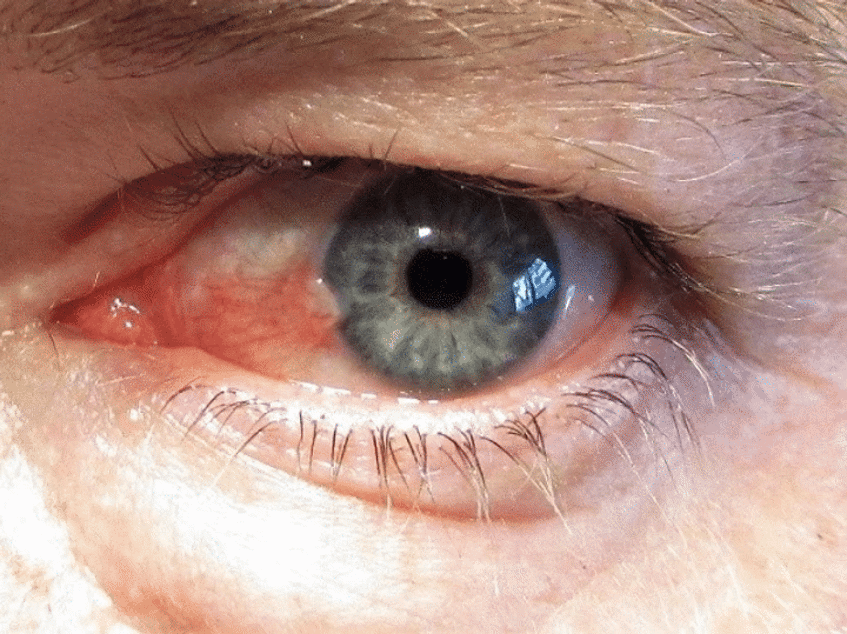If you have noticed a white spot on your eye or are experiencing symptoms that include stinging, burning, discharge or sensitivity to light, you may have a corneal ulcer.
Even if you can’t see the ulcer, it is likely you will be experiencing eye pain, and it’s very important to see your optician or seek medical help in an emergency.
What exactly is an eye ulcer, what causes them and are they treatable? In this article we run through the key symptoms and treatment options that may be available to you.

What is a corneal ulcer?
A corneal ulcer can affect the eyelids, the insides of the eyelids, and the cornea. They are classed as an ophthalmic emergency due to the potential to permanently impair your vision.
An ulcer can be caused by a bacterial infection after an eye injury or other damage to the delicate outer layer of the surface of your eye.
Contact lens wearers are particularly susceptible to eye irritation, either through the lens itself or wearer rubbing the eye, which can lead to an ulcer.
Another type of infection can be transmitted by skin contact. This is caused by the Herpes Simplex virus.
What is the difference between a corneal ulcer and an abrasion?
A corneal ulcer is different to an abrasion on your cornea.
An abrasion is usually caused by some kind of physical trauma, such as a foreign object, which has damaged the cornea.
An ulcer is a wound on the cornea that has been caused by a bacterial infection affecting your eye.
Eye ulcer symptoms
Your symptoms may include:
- sore painful eye
- inflammation
- a discharge or pus in the eye
- blurred vision
- a white spot on the cornea.

Will a corneal ulcer heal itself?
It is very important to visit your doctor if your eye becomes sore, or if you have any of the above symptoms, as a corneal ulcer is a serious condition.
To ignore an eye ulcer could have very detrimental effect on your vision, and in worse cases, lead to blindness. With prompt treatment, most ulcers improve with minimal effect on your vision.
Is a corneal ulcer contagious?
The Type 1 Herpes Simplex Virus, which is the same type of bacteria that can cause cold sores around the mouth, can also affect your eyes. This type of virus is called Herpetic Keratitis.
This type of eye ulcer is very contagious. The infection may be passed on to your eyes after touching a blister or cold sore elsewhere on the face or body.
How do you treat an eye ulcer?
Contact lenses should be removed and not worn until the eye has healed. This can take two to three weeks or longer depending on the severity and you will be able to wear fresh contact lenses once your optometrist has given you the all clear.
When handling your contact lenses, it is important to keep your hands clean at all times and follow proper cleaning routines for your lenses as advised by your optician.
Eye makeup should not be worn when you have a corneal ulcer to avoid any further irritation.
Most ulcers disappear once treatment is started. Occasionally, in the most severe cases, a corneal transplant may be recommended by your optician or GP.
Corneal ulcer treatment at home
It is important to seek medical help if you experience any of these symptoms by visiting your optician or GP.
However, once you have received a diagnosis, you may find that placing a cool compress on your eyes can help to relieve symptoms.
It is important to remember not to rub the eye and cause further irritation. Ensure your hands are clean when applying treatment.

Using eyedrops for corneal ulcers
Depending on your symptoms and what has caused the ulcer on your cornea, you may be prescribed antibacterial eye drops. If the infection is caused by a fungal infection, antiviral drops may also be required. In severe cases, corticosteroid eye drops will be prescribed.
Your optician or GP will explain the treatment options available to you and answer any questions you may have.
Further reading
- Contact lens wearer? Here’s what to do if your lenses hurt your eyes
- What is dry eye and can it damage your eyes?
- What causes a white dot in the middle of your pupil?





